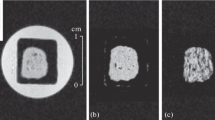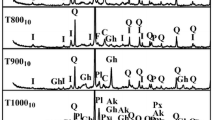Abstract
Magnetic Resonance Imaging (MRI) is applied to porous ceramic materials to study structural properties. In ceramics, processing differences create inhomogeneous binder distribution in the materials which can cause the formation of regions with differing densities and voids. These defects can be observed with MRI using solvent permeation. Fractional porosity obtained by using image intensity measurements and weight gain due to solvent permeation can be correlated. Dark regions in the image are due to defects such as closed voids, pockets of binder, or agglomerates. Defects such as voids or agglomerates usually have different magnetic susceptibilities. This difference causes artifacts in the image. By exploiting the increase in signal loss using a gradient-echo sequence, apparent enhancement of voids in ceramics is achieved.
Similar content being viewed by others
References
P. Mansfield and P. G. Morris, Adv. Magn. Reson. Suppl. 2 (1982).
C. Chang and R. A. Komoroski, Macromolecules 22, 600 (1989).
W. D. Hoff, C. Hall, R. J. Gummerson, R. Hawkes, G. N. Holland, and W.S. Moore, Nature 281, 56 (1979).
B. A. Baldwin, W. S. Yamanashi, and P. D. Lester, Magn. Reson. Imag. 3, 180 (1985).
P. C. Wang and S. J. Chang, Wood Fiber Sci. 308 (1986).
D. G. Cory, J. C. deBoer, and W. S. Veeman, Macromolecules 22, 1618 (1989).
A. N. Garroway, D. G. Cory, J. B. Miller, and R. Turner, Mol. Phys. 70 (2), 331 (1990).
K. M. Ludecke, P. Roschmann, and R. Tischler, Magn. Reson. Imag. 3, 329 (1985).
A. Ericsson, A. Hemmingsson, B. Jung, and G. O. Sperber, Phys. Med. Biol. 33, 1103 (1988).
S. Posse and W. P. Aue, J. Magn. Res. 88, 473 (1990).
R. D. Kapadia, Ph.D. Thesis (1990).
E. M. Haacke, Radiology 170, 457 (1989).
L. F. Czervionke, D. L. Daniels, F. W. Wehrli, L. P. Mark, L. E. Hendrix, J. A. Strandt, A. L. Williams, and V. M. Haughton, AJNR 9, 1149 (November/December 1988).
J. Frahm, K. D. Merbodldt, and W. Hanicke, Magn. Reson. Med. 6, 474 (1988).
J. L. Ackerman, W. A. Ellingson, J. D. Weyand, R. A. Dimilia, and L. Garrido, “Characterization of Porosity in Green State and Partially Densified A12O3 by NMRI”, Ceramic Engineering and Science Proc. 11th Ann. Conf. January 18–21, 1987.
E. M. Bellon, E. M. Haacke, P. E. Coleman, D. C. Sacco, D. A. Steiger, and R. E. Gangarosa, AJR 147, 1271 (1986).
Author information
Authors and Affiliations
Rights and permissions
About this article
Cite this article
Wallner, A.S., Ritchey, W.M. Void distribution and susceptibility differences in ceramic materials using MRI. Journal of Materials Research 8, 655–661 (1993). https://doi.org/10.1557/JMR.1993.0655
Received:
Accepted:
Published:
Issue Date:
DOI: https://doi.org/10.1557/JMR.1993.0655




